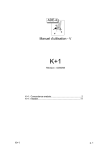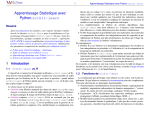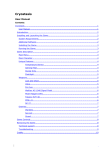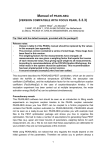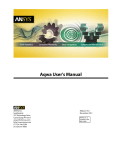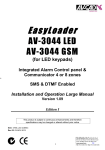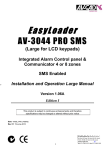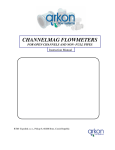Download QUEST User Manual
Transcript
QUEST User Manual Yu-Shan Shih Department of Mathematics National Chung Cheng University, Taiwan [email protected] Revised July 31, 2015 Contents 1 Introduction 1 2 Distribution files 2 3 Input files 3.1 Data file . . . . . . . . . . . . . . . . . . . . . . . . . . . . . . 3.2 Description file . . . . . . . . . . . . . . . . . . . . . . . . . . 2 2 3 4 Running the program 4.1 Interactive mode . . . . . . . . . . . . . . . . . . . . . . . . . 4.2 Explanation of questions . . . . . . . . . . . . . . . . . . . . . 4.3 Batch mode . . . . . . . . . . . . . . . . . . . . . . . . . . . . 4 4 8 9 5 Sample output files 10 5.1 Annotated output . . . . . . . . . . . . . . . . . . . . . . . . 10 5.2 Explanation of annotations . . . . . . . . . . . . . . . . . . . 20 5.3 Linear combination splits . . . . . . . . . . . . . . . . . . . . 22 1 Introduction QUEST stands for “Quick, Unbiased, Efficient Statistical Trees” and is a program for tree-structured classification. The algorithms are described in Loh and Shih (1997). The performance of QUEST compared with other classification methods can be found in Lim et al. (2000). The main strengths of QUEST are unbiased variable selection and fast computational speed. In 1 2 Distribution files addition, it has options to perform CART-style exhaustive search and costcomplexity cross-validation pruning (Breiman et al.; 1984). The updated versions of QUEST can be obtained from http://www.math.ccu.edu.tw/~yshih/quest.html. For detailed changes made in the latest version, please read the companion history file: history.txt. This user manual explains how the program is executed and how the output is interpreted. 2 Distribution files QUEST is distributed in compiled executable files for the following computer systems: PC compatible: Microsoft Windows, Linux Apple computer: Mac OS X Yosemite 10.10.4. The QUEST trees are given in outline form suitable for importing into flowchart packages like allCLEAR (CLEAR Software; 1996). Alternatively, the trees may be output in LATEX code. The public domain macro package pstricks (Goossens et al.; 1997) needed to render the LATEX trees. 3 Input files The QUEST program needs two text input files. 3.1 Data file This file contains the learning (or training) samples. Each sample consists of observations on the class (or response or dependent) variable and the predictor (or independent) variables plus any frequency variable. The entries in each sample record should be comma or space delimited. Each record can occupy one or more lines in the file, but each record must begin on a new line. Record values can be numerical or character strings. Categorical variables can be given numerical or character values. Any character string that contains a comma or space must be surrounded by a matching pair of quotation marks (either ’ or "). Please make sure that either the data file or the description file ends with a carriage return. Otherwise, the program will ignore all incomplete lines and may yield false results. 2 QUEST manual 3.2 3.2 Description file Description file This file is used to provide information to the program about the name of the data file, the names and the column locations of the variables, and their roles in the analysis. The following is an example file (hepdsc.txt) included with the distribution file. hepdat.txt "?" column, var, type 1 Class d 2 AGE n 3 SEX c 4 STEROID c 5 ANTIVIRALS c 6 FATIGUE c 7 MALAISE c 8 ANOREXIA c 9 BIGLIVER c 10 FIRMLIVER c 11 SPLEEN c 12 SPIDERS c 13 ASCITES c 14 VARICES c 15 BILIRUBIN n 16 ALKPHOSPHATE n 17 SGOT n 18 ALBUMIN n 19 PROTIME n 20 HISTOLOGY c The content of the file is explained in the following. 1. The first line gives the name of the learning sample. 2. The second line gives the code that denotes a missing value in the data. A missing value code must be present in the second line even if there are no missing value in the data (in which case any character string not present in the data file can be used). If the string contains characters other than alphabets or numbers, it must be surrounded by quotation marks. 3 QUEST manual 4 Running the program 3. The third line contains three character strings to indicate column headers for the subsequent lines. 4. The position, name and role of each variable comes next with one line for each variable. The following roles for the variables are permitted: c This is a categorical variable. d This is the class (dependent) variable. Only one variable can have the d indicator. n This is a numerical variable. f This is a frequency variable. It is the number of replications for each record and thus must be great than or equal to 0. Only one variable can have the f indicator. x This indicates that the variable is excluded from the analysis. 4 Running the program The QUEST program can be executed in interactive or batch modes. The virtual memory can be changed on various platforms for running the program on large data sets. On Linux machines, the user can use all the memory that the system allows by typing the command unlimit. On PC Windows machines, the user can change the size of the virtual memory in the system folder in the control panel. Since the format for text file on PC Windows is not the same as that on Linux, it may be helpful to convert the text format by the Linux command dos2unix if the file is originally tested on PC. This step can avoid some potential run-time errors. An example session log for the hepatitis data (Diaconis and Efron; 1983) obtained from the UCI Repository of Machine Learning Databases (Lichman; 2013) follows. 4.1 Interactive mode The QUEST program can be executed by simply typing its name at the prompt. Following is an annotated example session log for the Linux version (annotations are printed in italics). The PC version is similar. Whenever the user is prompted for a selection, a recommended choice is usually given. The latter may be selected by hitting the ENTER or RETURN key. > quest 4 QUEST manual 4.1 Interactive mode QUEST version 1.9 Copyright(c) 1997-2004 by Shih, Yu-Shan This version was updated on: April 27, 2004 Q0 Input 0 to 1 to 2 to Input 0, 1 read the warrenty disclaimer run QUEST in interactive mode create input file for batch job or 2 ([1:2], <cr>=1): Q1 Input name of file to store results: hep.out Q2 You should have a file with the following codes for each variable: d=dependent, n=numerical, c=categorical, f=frequency, x=excluded from analysis. Use commas or spaces as delimiters. Input name of variable description file (enclose within quotes if it contains embedded spaces): hepdsc.txt Q3 Code for missing values: ? Number of cases in data file: 155 There are missing values in the learning sample Number of learning samples: 155 Cases with 1 or more missing values: 75 Percentage of missing values: 5.67% Number of numerical variables: 6 Number of categorical variables: 13 Input 1 for default options, 2 for advanced options ([1:2], <cr>=1):2 Number of classes: 2 Q4 Input priors 1 for estimated, 2 for equal, 3 for given ([1:3], <cr>=1):1 5 QUEST manual 4.1 Interactive mode Q5 Input Input Input Input Input misclassification costs 1 for equal, 2 for given ([1:2], <cr>=1):2 the cost of predicting class die as class die ([0.000:], <cr>=0.000):0. the cost of predicting class live as class die ([1.000:], <cr>=1.000):1. the cost of predicting class die as class live ([1.000:], <cr>=1.000):2. the cost of predicting class live as class live ([0.000:], <cr>=0.000):0. Q6 Input minimal node size of constructed tree ([1:155], <cr>=5):5 Q7 Input splitting method: 1 for univariate, 2 for linear ([1:2], <cr>=1):1 Q8 Input variable selection method 1: (unbiased) statistical tests 2: (biased) exhaustive search Input 1 or 2 ([1:2], <cr>=1):1 Q9 Input the alpha value ([0.1000E-02:0.9990], <cr>=0.5000E-01):0.05 Q10 Input method of split point selection 1: discriminant analysis 2: exhaustive search Input 1 or 2 ([1:2], <cr>=2):2 Input 1 for 2 for 3 for 4 for 5 for Input splitting criterion likelihood ratio G^2 Pearson chi^2 Gini MPI other members of the divergence family 1, 2, 3, 4, or 5 ([1:5], <cr>=1):2 Q11 Input number of SEs for pruning ([0.000:], <cr>=1.000):0.0 6 QUEST manual 4.1 Interactive mode Q12 Input 1 to prune by CV, 2 to prune by test sample ([1:2], <cr>=1):1 Q13 Input number of fold ([2:155], <cr>=10):155 Q14 Input 1 if you DO NOT want test sample estimate, else 2 Input 1 or 2 ([1:2], <cr>=1): Q15 Input 1 if you do NOT want the details for CV trees, else 2 Input 1 or 2 ([1:2], <cr>=1):1 Q16 Input Input Input Input 1 if name 1 if 1 if you do NOT of file to you do NOT you do NOT want Pstricks LaTeX code, else 2 ([1:2], <cr>=1):2 store Pstricks LaTeX code: hep.tex want TreeTeX LaTeX code for tree, else 2 ([1:2], <cr>=1): want allCLEAR code for tree, else 2 ([1:2], <cr>=1): Q17 Input 1 if you do NOT want to save the class label and terminal node id for each case in the learning sample; input 2 otherwise Input 1 or 2 ([1:2], <cr>=1):2 Input name of file to store node ids: hep.nid Cross-validation is executing. Please wait (Each row of dots signifies 50 iterations completed.) .................................................. .................................................. .................................................. ..... Q18 Number of terminal nodes of final tree = 7 Pstricks codes are stored in file: hep.tex Case ids, class label, terminal ids and predicted label for the learning sample are in file: hep.nid Results are stored in file: hep.out elapsed time: 30.71 seconds (user: 29.43, system: 1.28) 7 QUEST manual 4.2 4.2 Explanation of questions Explanation of questions Following is a brief explanation of the questions asked by the program. The default choice for each question is indicated by the carriage-return symbol <cr>=. It can be chosen by simply hitting the carriage return key. Q0. QUEST allows both interactive and batch mode. If the answer if 1, it will start with interactive mode. If the answer is 2, the program will ask all the options first and store those options into a file (name is given by the user) for running in batch mode. Q1. This question asks for a file to store the results. If a file by that name already exists, the user is asked to either overwrite it or choose another name. Q2. This asks for the description file. If the file is read correctly, the code for missing values is printed to the screen and a brief summary of the learning data is printed to the screen. Q3. This allows the user either to select all default options or to control every step of the run. If the first choice is selected, the run will skip all the later questions. The number of classes is printed to the screen. Q4. This asks for the prior for each class. If the priors are to be given, the program will then ask the user to input the priors. Q5. This asks for the misclassification costs. If the costs are to be given, the program will ask the user to input the costs (like in this example). Q6. This asks for the smallest number of samples in a node during tree construction. A node will not be split if it contains fewer cases than this number. The smaller this value is, the larger the initial tree will be prior to pruning. The default value is max(5, n/100), where n is the total number of observations. Q7. The user can choose either splits on single variable or linear combination of variables. Q8. This asks for the user to choose between the unbiased variable selection method described in Loh and Shih (1997) or the biased exhaustive search method which is used in CART. Q9. If the unbiased method based on statistical tests is used in Q8, this asks for the alpha value to conduct the tests. The suggest value is usually best. 8 QUEST manual 4.3 Batch mode Q10. For the split point, this asks for the user to choose between methods using discriminant analysis (Loh and Shih; 1997) and the exhaustive search method (Breiman et al.; 1984). The former is the default option if the number of classes is more than 2, otherwise the latter is the default option. If the latter option is selected, the program will ask for the user to choose the splitting criterion. These criteria are studied in Shih (1999). The likelihood criterion is the default option. If instead the CART-style split is used, the Gini criterion is the default option. Q11. The number of SEs controls the size of the pruned tree. 0-SE gives the tree with the smallest cross-validation estimate of misclassification cost or error. Q12. The user can choose to select the final tree by cross-validation or test sample pruning. Test sample estimates are available for both trees. Q13. This asks for the value of V in V-fold cross-validation. The larger the value of V is, the longer running time the program takes. 10-fold is usually recommended and is the default in CART. Q14. The test sample estimate can be obtained for the final CV tree, if it is needed. Q15. The details of CV tree sequences are reported, if the user chooses 2. They are not reported by default. Q16. If LATEX source code for drawing the tree is needed, the user should choose 2 to use either pstricks or TreeTEX package. So is allCLEAR code. Q17. This allows the user to obtain a file containing the class label and terminal node for each case in the learning sample. The information is useful for extracting the learning samples from particular terminal nodes of the tree. Q18. After the tree is built, some related information is printed to the screen. 4.3 Batch mode If the answer in Q0 is 2, QUEST will ask for a file to store the selected options. It also checks the description file and the data file. However, it does not construct the tree. After all the questions being asked, QUEST will prompt the command for running a job in batch mode. 9 QUEST manual 5 Sample output files 5 Sample output files The annotated output file hep.out is in the following. 5.1 Annotated output @@@ @ @ @ @ @ @ @ @ @ Q @ @ Q@ @@@ Q U U Q Q Q Q Q Q QUUQ Eee Q Eee Q Eee Sss Q Sss Q Sss TTTTT Q Q Q Q Classification tree program: QUEST version 1.9 Copyright(c) 1997-2004, by Shih, Yu-Shan This version was updated on: April 27, 2004 Please send comments, questions, or bug reports to [email protected] This job was started on: 04/27/2004 at: 10:48 P1 Variable description file: hepdsc.txt Learning sample file: hepdat.txt Code for missing values: ? Variables in data file are (variable types are d=dependent, n=numerical, c=categorical, f=frequency, x=excluded): Column # Variable name Variable type 1 Class d 2 AGE n 3 SEX c 4 STEROID c 5 ANTIVIRALS c 6 FATIGUE c 7 MALAISE c 8 ANOREXIA c 10 QUEST manual 5.1 9 10 11 12 13 14 15 16 17 18 19 20 BIGLIVER FIRMLIVER SPLEEN SPIDERS ASCITES VARICES BILIRUBIN ALKPHOSPHA SGOT ALBUMIN PROTIME HISTOLOGY Annotated output c c c c c c n n n n n c P2 Number of cases in data file: 155 Number of learning samples: 155 Cases with 1 or more missing values: 75 Percentage of missing values: 5.67% Number of numerical variables: 6 Number of categorical variables: 13 P3 Summary of response variable: Class class frequency die 32 live 123 -------155 Summary of numerical variable: AGE Size Obs Min Max Mean Sd 155 155 0.700E+01 0.780E+02 0.412E+02 0.126E+02 Summary of categorical variable: SEX category frequency female 16 male 139 -------155 11 QUEST manual 5.1 Annotated output Summary of categorical variable: STEROID category frequency no 78 yes 76 -------154 missing 1 Summary of categorical variable: ANTIVIRALS category frequency no 131 yes 24 -------155 Summary of categorical variable: FATIGUE category frequency no 54 yes 100 -------154 missing 1 Summary of categorical variable: MALAISE category frequency no 93 yes 61 -------154 missing 1 Summary of categorical variable: ANOREXIA category frequency no 122 yes 32 -------154 missing 1 Summary of categorical variable: BIGLIVER 12 QUEST manual 5.1 category no yes missing Annotated output frequency 120 25 -------145 10 Summary of categorical variable: FIRMLIVER category frequency no 84 yes 60 -------144 missing 11 Summary of categorical variable: SPLEEN category frequency no 120 yes 30 -------150 missing 5 Summary of categorical variable: SPIDERS category frequency no 99 yes 51 -------150 missing 5 Summary of categorical variable: ASCITES category frequency no 130 yes 20 -------150 Summary of categorical variable: VARICES 13 QUEST manual 5.1 category no yes missing Annotated output frequency 132 18 -------150 5 Summary of numerical variable: BILIRUBIN Size Obs Min Max Mean Sd 155 149 0.300E+00 0.800E+01 0.143E+01 0.121E+01 Summary of numerical variable: ALKPHOSPHATE Size Obs Min Max Mean Sd 155 126 0.260E+02 0.295E+03 0.105E+03 0.515E+02 Summary of numerical variable: SGOT Size Obs Min Max Mean Sd 155 151 0.140E+02 0.648E+03 0.859E+02 0.897E+02 Summary of numerical variable: ALBUMIN Size Obs Min Max Mean Sd 155 139 0.210E+01 0.640E+01 0.382E+01 0.652E+00 Summary of numerical variable: PROTIME Size Obs Min Max Mean Sd 155 88 0.000E+00 0.100E+03 0.619E+02 0.229E+02 Summary of categorical variable: HISTOLOGY category frequency no 85 yes 70 -------155 Options for tree construction estimated priors are Class prior die 0.20645 live 0.79355 The cost matrix is in the following format 14 QUEST manual 5.1 Annotated output cost(1|1),cost(1|2),.....,cost(1|no. of class) cost(2|1),cost(2|2),.....,cost(2|no. of class) .............................................. .............................................. cost(no. of class|1),.. .,cost(no. of class|no. of class) where cost(i|j)= cost of misclassifying class j as class i and class label is assigned in alphabetical order 0.0000000E+00 1.000000 2.000000 0.0000000E+00 The altered priors are die:.34225 live:.65775 P4 minimal node size: 5 use univariate split use (unbiased) statistical tests for variable selection alpha value: .050 split point method: exhaustive search use Pearson chi^2 P5 use 155-fold CV sample pruning SE-rule trees based on number of SEs = 0.00 P6 subtree number 1 2 3 4 5 6 # Terminal nodes 15 9 8 7 2 1 complexity value 0.0000 0.0043 0.0065 0.0129 0.0284 0.1677 current cost 0.0581 0.0839 0.0903 0.1032 0.2452 0.4129 P7 Size and CV misclassification cost and SE of subtrees: Tree #Tnodes Mean SE(Mean) 15 QUEST manual 5.1 1 2 3 4** 5 6 15 9 8 7 2 1 0.3355 0.3419 0.3290 0.2903 0.3226 0.4129 Annotated output 0.4937E-01 0.5034E-01 0.5089E-01 0.4911E-01 0.4556E-01 0.6502E-01 CART 0-SE tree is marked with * CART SE-rule using CART SE is marked with ** The * and ** trees are the same P8 Following tree is based on * Structure of final tree Node 1 2 4 6 8 9 14 15 16 17 7 5 3 Left node Right node 2 3 4 5 6 7 8 9 * terminal node * 14 15 * terminal node * 16 17 * terminal node * * terminal node * * terminal node * * terminal node * * terminal node * Split variable ALBUMIN BILIRUBIN ASCITES MALAISE Predicted class live STEROID live PROTIME die live die die live Number of terminal nodes of final tree = 7 Total number of nodes of final tree = 13 P9 Classification tree: Node 1: ALBUMIN <= 3.850 Node 2: BILIRUBIN <= 3.700 Node 4: ASCITES = no 16 QUEST manual 5.1 Annotated output Node 6: MALAISE = no Node 8: live Node 6: MALAISE = yes Node 9: STEROID = no Node 14: live Node 9: STEROID = yes Node 15: PROTIME <= 70.50 Node 16: die Node 15: PROTIME > 70.50 Node 17: live Node 4: ASCITES = yes Node 7: die Node 2: BILIRUBIN > 3.700 Node 5: die Node 1: ALBUMIN > 3.850 Node 3: live P10 Information for each node: ************************************************** Node 1: Intermediate node A case goes into Node 2 if its value of ALBUMIN <= 3.8500 Class # cases Mean of ALBUMIN die 32 3.1519 live 123 3.9777 -------155 ************************************************** Node 2: Intermediate node A case goes into Node 4 if its value of BILIRUBIN <= 3.7000 Class # cases Mean of BILIRUBIN die 29 2.6222 live 32 1.3687 -------61 ************************************************** Node 4: Intermediate node A case goes into Node 6 if its value of ASCITES = 17 QUEST manual 5.1 Annotated output no Class # cases Mode of ASCITES die 21 no live 32 no -------53 ************************************************** Node 6: Intermediate node A case goes into Node 8 if its value of MALAISE = no Class # cases Mode of MALAISE die 12 yes live 28 no -------40 ************************************************** Node 8: Terminal node assigned to Class live Class # cases die 3 live 18 ------21 ************************************************** Node 9: Intermediate node A case goes into Node 14 if its value of STEROID = no Class # cases Mode of STEROID die 9 yes live 10 yes -------19 ************************************************** Node 14: Terminal node assigned to Class live Class # cases die 0 live 4 ------4 ************************************************** Node 15: Intermediate node 18 QUEST manual 5.1 Annotated output A case goes into Node 16 if its value of PROTIME <= 70.500 Class # cases Mean of PROTIME die 9 36.333 live 6 100.00 -------15 ************************************************** Node 16: Terminal node assigned to Class die Class # cases die 9 live 0 ------9 ************************************************** Node 17: Terminal node assigned to Class live Class # cases die 0 live 6 ------6 ************************************************** Node 7: Terminal node assigned to Class die Class # cases die 9 live 4 ------13 ************************************************** Node 5: Terminal node assigned to Class die Class # cases die 8 live 0 ------8 ************************************************** Node 3: Terminal node assigned to Class live Class # cases die 3 live 91 19 QUEST manual 5.2 Explanation of annotations ------94 P11 Classification matrix based on learning sample predicted class actual class die live die 26 6 live 4 119 Classification matrix based on 155-fold CV predicted class actual class die live die 19 13 live 19 104 P12 Pstricks codes are stored in file: hep.tex Case ids, class label, terminal ids and predicted label for the learning sample are in file: hep.nid elapsed time: 30.71 seconds (user: 29.43, system: 1.28) This job was completed on: 04/27/2004 5.2 at: 10:49 Explanation of annotations P1. This paragraph shows some of the information obtained from the user during the interaction session. The names of the description and data files, the code for missing values, and the content of the description file are reported. Character strings in variable names which are longer than 10 characters are truncated. P2. Counts are given of the total number of cases, number of cases with nonmissing dependent values, number of cases with one or more missing values, percentage of missing values and the numbers of variables of each type. P3. Summary statistics are shown for each included variable, if the ad20 QUEST manual 5.2 Explanation of annotations vanced option is selected. In addition, the priors are listed. If unequal costs are present (like in this example), the priors are altered using the formula in Breiman et al. (1984, pp. 114-115). P4. Additional options selected for this run are given here. P5. The number of SEs for the pruning rule and the number of folds of crossvalidation are shown here. If the details option in Q14 is selected, the sequence of pruned subtrees is also given for each fold. P6. This table gives the sequence of pruned subtrees. The 3rd column shows the cost complexity value for each subtree using the definition in Breiman et al. (1984, Definition 3.5 p. 66). The 4th column gives the current or resubstitution cost (error) for each subtree. P7. This table gives the size, estimate of misclassification cost and its standard error for each pruned subtree. The 2nd column shows the number of terminal nodes. The 3rd column shows the mean cross-validation estimate of misclassification cost and the 4th column gives its estimated standard error using the approximate formula in Breiman et al. (1984, pp. 306-309). The tree marked with an asterisk (*) is the one with the minimum mean cross-validation estimate of misclassification cost (also called the 0-SE tree). The tree based on the mean cross-validation estimate of misclassification cost and the number of SEs shown in P6 is marked with two asterisks (**). P8. The structure of the tree selected by the user (the tree marked by ** in this example) is given here. The root node always has the label 1. The total number of nodes and terminal nodes are also shown. P9. The tree structure in outline form suitable for importing into flow-chart programs such as allCLEAR is given here. The formatted LATEX tree using pstricks package is shown in Figure 5.2. P10. Details of the split, summary of classes for each node, and the node assignment are given here. P11. The classification matrices based on the learning sample and CV procedure are reported. P12. The file name for the pstricks tree and the file name for the terminal node id are given here, if either option is selected. The total CPU time taken by the run is also reported. 21 QUEST manual 5.3 5.3 Linear combination splits Linear combination splits The following example shows the output file for the hepatitis data set using linear combination splits (choice 2 in Q7 ) with all the other options unchanged. @@@ @ @ @ @ @ @ @ @ @ Q @ @ Q@ @@@ Q U U Q Q Q Q Q Q QUUQ Eee Q Eee Q Eee Sss Q Sss Q Sss TTTTT Q Q Q Q Classification tree program: QUEST version 1.9 Copyright(c) 1997-2004, by Shih, Yu-Shan This version was updated on: April 27, 2004 Please send comments, questions, or bug reports to [email protected] This job was started on: 04/27/2004 at: 10:52 Variable description file: hepdsc.txt Learning sample file: hepdat.txt Code for missing values: ? Variables in data file are (variable types are d=dependent, n=numerical, c=categorical, f=frequency, x=excluded): Column # Variable name Variable type 1 Class d 2 AGE n 3 SEX c 4 STEROID c 5 ANTIVIRALS c 6 FATIGUE c 7 MALAISE c 8 ANOREXIA c 9 BIGLIVER c 22 QUEST manual 5.3 Linear combination splits 10 FIRMLIVER c 11 SPLEEN c 12 SPIDERS c 13 ASCITES c 14 VARICES c 15 BILIRUBIN n 16 ALKPHOSPHA n 17 SGOT n 18 ALBUMIN n 19 PROTIME n 20 HISTOLOGY c Number of cases in data file: 155 Number of learning samples: 155 Cases with 1 or more missing values: 75 Percentage of missing values: 5.67% Number of numerical variables: 6 Number of categorical variables: 13 Summary of response variable: Class class frequency die 32 live 123 -------155 Summary of numerical variable: AGE Size Obs Min Max Mean Sd 155 155 0.700E+01 0.780E+02 0.412E+02 0.126E+02 Summary of categorical variable: SEX category frequency female 16 male 139 -------155 Summary of categorical variable: STEROID category frequency no 78 yes 76 23 QUEST manual 5.3 missing Linear combination splits -------154 1 Summary of categorical variable: ANTIVIRALS category frequency no 131 yes 24 -------155 Summary of categorical variable: FATIGUE category frequency no 54 yes 100 -------154 missing 1 Summary of categorical variable: MALAISE category frequency no 93 yes 61 -------154 missing 1 Summary of categorical variable: ANOREXIA category frequency no 122 yes 32 -------154 missing 1 Summary of categorical variable: BIGLIVER category frequency no 120 yes 25 -------24 QUEST manual 5.3 missing Linear combination splits 145 10 Summary of categorical variable: FIRMLIVER category frequency no 84 yes 60 -------144 missing 11 Summary of categorical variable: SPLEEN category frequency no 120 yes 30 -------150 missing 5 Summary of categorical variable: SPIDERS category frequency no 99 yes 51 -------150 missing 5 Summary of categorical variable: ASCITES category frequency no 130 yes 20 -------150 missing 5 Summary of categorical variable: VARICES category frequency no 132 yes 18 -------25 QUEST manual 5.3 missing Linear combination splits 150 5 Summary of numerical variable: BILIRUBIN Size Obs Min Max Mean Sd 155 149 0.300E+00 0.800E+01 0.143E+01 0.121E+01 Summary of numerical variable: ALKPHOSPHATE Size Obs Min Max Mean Sd 155 126 0.260E+02 0.295E+03 0.105E+03 0.515E+02 Summary of numerical variable: SGOT Size Obs Min Max Mean Sd 155 151 0.140E+02 0.648E+03 0.859E+02 0.897E+02 Summary of numerical variable: ALBUMIN Size Obs Min Max Mean Sd 155 139 0.210E+01 0.640E+01 0.382E+01 0.652E+00 Summary of numerical variable: PROTIME Size Obs Min Max Mean Sd 155 88 0.000E+00 0.100E+03 0.619E+02 0.229E+02 Summary of categorical variable: HISTOLOGY category frequency no 85 yes 70 -------155 Options for tree construction estimated priors are Class prior die 0.20645 live 0.79355 The cost matrix is in the following format cost(1|1),cost(1|2),.....,cost(1|no. of class) cost(2|1),cost(2|2),.....,cost(2|no. of class) .............................................. .............................................. 26 QUEST manual 5.3 Linear combination splits cost(no. of class|1),.. .,cost(no. of class|no. of class) where cost(i|j)= cost of misclassifying class j as class i and class label is assigned in alphabetical order 0.0000000E+00 1.000000 2.000000 0.0000000E+00 The altered priors are die:.34225 live:.65775 minimal node size: 5 use linear split split point method: exhaustive search use Pearson chi^2 use 155-fold CV sample pruning SE-rule trees based on number of SEs = 0.00 subtree number 1 2 3 4 # Terminal nodes 5 3 2 1 complexity value 0.0000 0.0129 0.0387 0.3355 current cost 0.0129 0.0387 0.0774 0.4129 Size and CV misclassification cost and SE of subtrees: Tree #Tnodes Mean SE(Mean) 1 5 0.2581 0.4900E-01 2 3 0.2258 0.4612E-01 3** 2 0.2194 0.4208E-01 4 1 0.4129 0.6502E-01 CART 0-SE tree is marked with * CART SE-rule using CART SE is marked with ** The * and ** trees are the same Following tree is based on * Structure of final tree 27 QUEST manual 5.3 Node Left node Right 1 2 2 * terminal node 3 * terminal node node 3 * * Linear combination splits Split variable linear Predicted class die live Number of terminal nodes of final tree = 2 Total number of nodes of final tree = 3 Classification tree: Node 1: linear combination <= 0.1307 Node 2: die Node 1: linear combination > 0.1307 Node 3: live Information for each node: ************************************************** Node 1: Intermediate node Class # cases die 32 live 123 -------155 A case goes into Node 2 if a linear combination of variables <= 0.1307 The coefficients in Variable AGE SEX STEROID ANTIVIRALS FATIGUE MALAISE ANOREXIA BIGLIVER FIRMLIVER SPLEEN the linear combination are: Coefficient -0.2988E-03 0.1819 0.5505E-01 -0.3659E-01 -0.2138E-01 0.2194 -0.1964 0.7677E-01 -0.1026 0.9356E-01 28 QUEST manual 5.3 SPIDERS ASCITES VARICES BILIRUBIN ALKPHOSPHATE SGOT ALBUMIN PROTIME HISTOLOGY Linear combination splits 0.2537 0.1549 0.4411E-01 -0.1977E-01 0.8270E-04 0.4785E-04 0.3183E-01 0.1206E-02 0.3936E-01 The CRIMCOORD values assiciated with each categorical variable variable SEX category female male variable STEROID category no yes variable ANTIVIRALS category no yes variable FATIGUE category no yes variable MALAISE category no yes variable ANOREXIA category no yes variable BIGLIVER category no yes CRIMCOORD 0.131776 -0.131776 CRIMCOORD 0.802351E-01 -0.802351E-01 CRIMCOORD -0.110913 0.110913 CRIMCOORD 0.839007E-01 -0.839007E-01 CRIMCOORD 0.816611E-01 -0.816611E-01 CRIMCOORD 0.991144E-01 -0.991144E-01 CRIMCOORD -0.109190 0.109190 29 QUEST manual 5.3 Linear combination splits variable FIRMLIVER category CRIMCOORD no 0.821155E-01 yes -0.821155E-01 variable SPLEEN category CRIMCOORD no 0.101177 yes -0.101177 variable SPIDERS category CRIMCOORD no 0.842006E-01 yes -0.842006E-01 variable ASCITES category CRIMCOORD no 0.118011 yes -0.118011 variable VARICES category CRIMCOORD no 0.124193 yes -0.124193 variable HISTOLOGY category CRIMCOORD no 0.801872E-01 yes -0.801872E-01 ************************************************** Node 2: Terminal node assigned to Class die Class # cases die 30 live 8 ------38 ************************************************** Node 3: Terminal node assigned to Class live Class # cases die 2 live 115 ------117 Classification matrix based on learning sample 30 QUEST manual REFERENCES predicted class actual class die live die 30 2 live 8 115 Classification matrix based on 155-fold CV predicted class actual class die live die 24 8 live 18 105 elapsed time: 59.53 seconds (user: 58.45, system: 1.08) This job was completed on: 04/27/2004 at: 10:53 The linear combination splits and the associated CRIMCOORD values for each categorical variables are given in terms of their coefficients printed at the end of each intermediate node. References Breiman, L., Friedman, J. H., Olshen, R. A. and Stone, C. J. (1984). Classification And Regression Trees, Wadsworth, Belmont, CA. CLEAR Software, I. (1996). allCLEAR User’s Guide, CLEAR Software, Inc, 199 Wells Avenue, Newton, MA. Diaconis, P. and Efron, B. (1983). Computer-intensive methods in statistics, Scientific American 248: 96–108. Goossens, M., Rahtz, S. and Mittelbach, F. (1997). The LATEX Graphics Companion, Addison Wesley. Lichman, M. (2013). UCI machine learning repository. URL: http://archive.ics.uci.edu/ml Lim, T.-S., Loh, W.-Y. and Shih, Y.-S. (2000). A comparison of prediction accuracy, complexity, and training time of thirty-three old and new classification algorithms, Machine Learning 40: 203–228. Loh, W.-Y. and Shih, Y.-S. (1997). Split selection methods for classification trees, Statistica Sinica 7: 815–840. 31 QUEST manual REFERENCES Shih, Y.-S. (1999). Families of splitting criteria for classification trees, Statistics and Computing 9: 309–315. 32 QUEST manual REFERENCES ALBUMIN ≤ 3.850 BILIRUBIN ≤ 3.700 3|91 live ASCITES ∈ S4 MALAISE ∈ S6 8|0 die 9|4 die STEROID ∈ S9 3|18 live PROTIME ≤ 70.50 0|4 live 9|0 0|6 die live Figure 1: The value beneath a terminal node is the predicted class for the node; and the numbers beside a terminal node is the numbers of learning samples for each class in the node. Their class labels, from left to right, are die, live. Splitting rule for each intermediate node is given beside the node. 33 QUEST manual

































